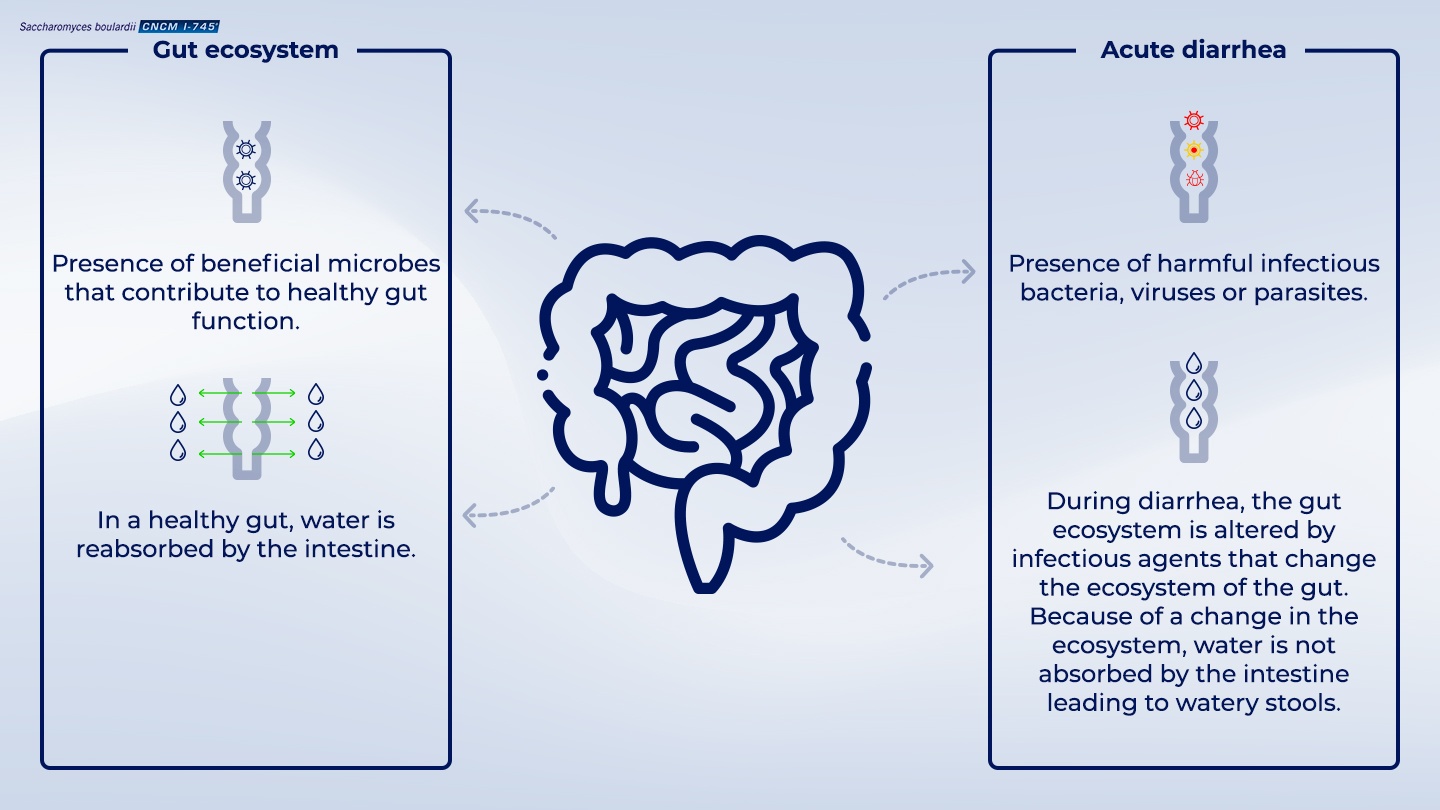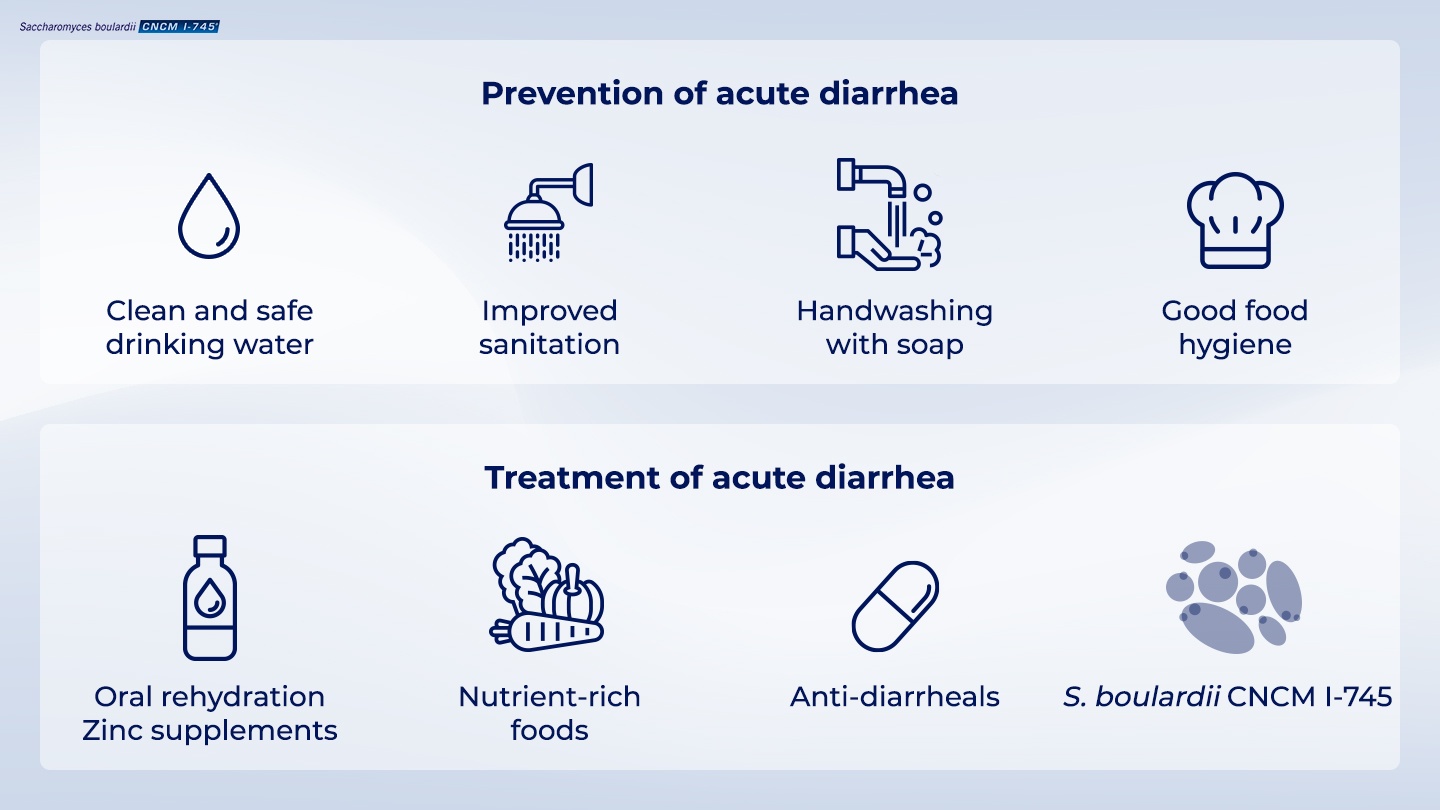Acute diarrhea and Saccharomyces boulardii CNCM I-745
- Video
- 5 min
What is acute diarrhea?
Acute diarrhea is defined as 3 or more watery or loose stools per day1,2, and is a common problem globally.1 According to the World Health Organisation (WHO),
Along with watery stools, people can also experience nausea/vomiting, stomach cramps or fever.2 Acute diarrhea can last for several hours to a few days.3
What causes acute diarrhea?
One common cause of acute diarrhea includes infectious agents such as viruses, bacteria and parasites.1 Sources for these agents include : 1,2
- Unhygienic food preparation
- Contaminated water and/or food
- Person-to-person transmission
Other causes of acute diarrhea can be non-infectious such as from antibiotics.4
Diarrhea occurs from the effect of these infectious and non-infectious agents on both the gut and the gut microbiota intestinal. Exposure to one of these aforementioned causes of diarrhea disturbs the gut by increasing inflammation, damaging cells and increasing water secretion/reducing absorption.4
Harmful bacteria can also outcompete with beneficial microbiota, leading to reduced levels of these helpful microbes that result in reduced digestion of food, leading to malabsorption of nutrients and an increase of water in the gut.5
The increase in water results in diarrhea.5

(Internal code : 20.60)
How do we prevent and treat diarrhea?
Simple steps to preventing diarrhea can include : 1
- Hand washing with soap
- Good food hygiene
- Improved sanitation
- Clean and safe drinking water
The key treatments for acute diarrhea are:
- Oral rehydration therapy1
- Anti-diarrheal treatment2
- Zinc supplements2
- Nutrient-rich food2
- Probiotics2
Dehydration is the most severe threat of diarrhea, as water and electrolytes are lost with each diarrhea episode.1 Therefore the key treatment is rehydration.1 During acute diarrhea, oral rehydration solution should be taken, which consists of sugar, salts and water, and helps the intestine reabsorb water and electrolytes.1
Zinc deficiency can suppress the immune system and lead to more severe diarrhea.2 Zinc supplements are recommended by the WHO, especially for children2, as they reduce the duration of diarrhea and stool volume.1
Children who are suffering from malnutrition are more susceptible to diarrhea, and diarrhea in turn can result in malnutrition.1 Therefore the WHO recommends that, nutrient-rich food should be given during an episode to those who are well enough.1
Other treatments include non-specific anti-diarrheals and antimicrobial drugs2, however these are not applicable for all cases of acute diarrhea.2

1,2,4
(Internal code : 20.60)
Probiotics as a treatment for diarrhea
Due to their mechanisms of action to address the disturbance to gut microbiota and demonstrated antimicrobial activity, probiotics are considered as an additional approach to treat acute diarrhea.6
One probiotic that has strong evidence demonstrating it can reduce the frequency and duration of AD is the yeast Saccharomyces boulardii CNCM I-745.6
This helps restore normal gut function.5
Taking S. boulardii CNCM I-745 during AD has been shown to reduce the duration and frequency of diarrhea in children3, and reduces the symptoms of diarrhea in adults.8
How does S. boulardii CNCM I-745 stop acute diarrhea?
S. boulardii CNCM I-745 can stop the causes of acute diarrhea in multiple ways:4
- Anti-toxin action – Degrades toxins or bind to them which prevents toxin-induced increases in water in the gut ;
- Anti-microbial activity – Stops harmful bacteria from attaching to the lining of the gut or from invading gut cells ;
- Anti-inflammatory activity – Reduces inflammation in the gut;
- Changes the environment of the gut – to favour growth of beneficial gut microorganisms which helps restore the normal functioning of the gut ;
- Helps maintain the normal physiology and immune defenses of the gut.
Because of the strength of the clinical evidence that has demonstrated that
Internal code : 20.27
References
- 01 . WHO. Diarrheal disease. https://www.who.int/news-room/fact-sheets/detail/diarrhoeal-disease. Last accessed 8th November 2019.
- 02 . Farthing M, et al. World Gastroenterology Organisation Global Guidelines: Acute diarrhea in adults and children. February 2012. https://www.worldgastroenterology.org/guidelines/global-guidelines/acute-diarrhea/acute-diarrhea-english. Last accessed 17th December 2019
- 03 . Feizizadeh S, Salehi-Abargouei A, and Akbari V. Efficacy and safety of Saccharomyces boulardii for acute diarrhea. Pediatrics. 2014. 134(1): e176-e191.
- 04 . McFarland, LV. Systematic review and meta-analysis of Saccharomyces boulardii in adult patients. World journal of gastroenterology: WJG. 2010; 16(18): 2202.
- 05 . More MI, and Swidsinski, A. Saccharomyces boulardii CNCM I-745 supports regeneration of the intestinal microbiota after diarrheic dysbiosis–a review. Clinical and experimental gastroenterology. 2015; 8: 237.
- 06 . Guarner et al. Probiotics and prebiotics. World Gastroenterology Organisation Global Guidelines. February 2017. https://www.worldgastroenterology.org/guidelines/global-guidelines/probiotics-and-prebiotics/probiotics-and-prebiotics-english. Last accessed 17th December 2019.
- 07 . Joly, F et al. 2017. Saccharomyces boulardii CNCM I-745. Marteau, P and Dore J (Ed.), Gut Microbiota: A full-fledged organ. 2017: 305-326. Paris: John Libbey Eurotext.
- 08 . Höchter, W, Chase D and Hagenhoff G. Saccharomyces boulardii in acute adult diarrhoea. Efficacy and tolerance of treatment. Münch Med Wochenschr. 1990; 132: 188-92.
- 09 . Guarino A, et al. European Society for Pediatric Gastroenterology, Hepatology, and Nutrition/European Society for Pediatric Infectious Diseases evidence-based guidelines for the management of acute gastroenteritis in children in Europe: update 2014. Journal of pediatric gastroenterology and nutrition. 2014; 59(1): 132-152.
